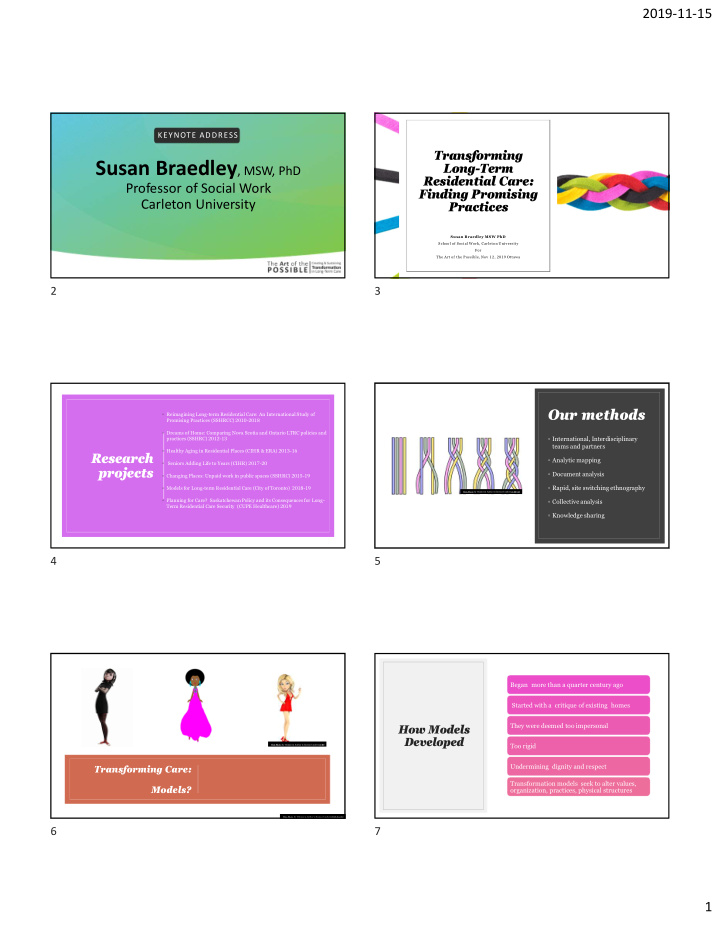



2019-11-15 KEYNOTE ADDRESS Transforming Susan Braedley , MSW, PhD Long-Term Residential Care: Professor of Social Work Finding Promising Carleton University Practices Susan Braedley MSW PhD School of Social Work, Carleton University For The Art of the Possible, Nov 12, 2019 Ottawa 2 3 Our methods ◦ Reimagining Long-term Residential Care: An International Study of Promising Practices (SSHRCC) 2010-2018 ◦ Dreams of Home: Comparing Nova Scotia and Ontario LTRC policies and practices (SSHRC) 2012-13 ◦ International, Interdisciplinary teams and partners ◦ Healthy Aging in Residential Places (CIHR & ERA) 2013-16 Research ◦ Analytic mapping ◦ Seniors Adding Life to Years (CIHR) 2017-20 projects ◦ Document analysis ◦ Changing Places: Unpaid work in public spaces (SSHRC) 2015-19 ◦ Rapid, site switching ethnography ◦ Models for Long-term Residential Care (City of Toronto) 2018-19 This Photo by Unknown Author is licensed under CC BY-SA ◦ Planning for Care? Saskatchewan Policy and its Consequences for Long- ◦ Collective analysis Term Residential Care Security (CUPE Healthcare) 2019 ◦ Knowledge sharing 4 5 Began more than a quarter century ago Started with a critique of existing homes They were deemed too impersonal How Models Developed Too rigid This Photo by Unknown Author is licensed under CC BY Undermining dignity and respect Transforming Care: Transformation models seek to alter values, Models? organization, practices, physical structures This Photo by Unknown Author is licensed under CC BY-SA-NC 6 7 1
2019-11-15 Examples of Montessori Methods for Dementia, Dementi/Ability Models There are also Approaches or ◦ Butterfly the most recent, Methods that The Gentle Care System ◦ Earlier, Eden, are not as extensive as models ◦ Green House, The Gentle Persuasive Approach ◦ Wellspring 8 9 Common elements (1) Long-term care home sector scandals, wait lists, continual critique ◦ Focus on care as a relationship and A Market residents as individuals Competition among and between for-profit, not- for Models for - profit and municipal homes ◦ Collaborative approaches ◦ Flexibility for residents and staff, empowerment Concurrent with changing admissions criteria, wait lists, and developments within the retirement home sector that shape a two-tier ◦ Preference for small, “homelike” places, plants, outdoor access system, ltrc intensity is growing in multiple ways This Photo by Unknown Author is licensed under CC BY 10 11 Common A Promising Practice : Short Video elements (2) ◦ Focus on care processes rather than on tasks ◦ Leadership committed to guiding principles ◦ Vary in degree of flexibility in application ◦ All require higher staffing levels, training This Photo by Unknown Author is licensed under CC BY 12 13 2
2019-11-15 SIGNIFICANT WHAT DIFFERENCES AMONG MODELS AND RESIDENTS IN APPROACHES TERMS OF AGE, OFTEN DO CULTURE, NOT ADDRESS INCOME, CAPACITIES, LANGUAGE, FAMILY STATUS This Photo by Unknown Author is licensed under CC BY 14 15 Transitioning ROLE OF FAMILIES AND VOLUNTEERS This Photo by Unknown Author is licensed under CC BY-NC-ND 16 17 Costing and funding Ontario health ministry spending ($ billions) STAFFING RECRUITMENT, RETENTION, PAY AND BENEFITS, UNION AGREEMENTS AND 11-12 12-13 13-14 14-15 15-16 16-17 17-18 18-19 19-20 REGULATIONS Long-Term Care 3.6 3.7 3.8 3.9 3.9 4.0 4.1 4.3 4.4 Homes Growth 1.7% 3.2% 2.2% 2.1% 1.9% 2.6% 3.9% 1.5% Source: FAO analysis of data from MOHLTC, the 2019 Ontario Budget and FAO. This Photo by Unknown Author is licensed under CC BY-NC 18 19 3
2019-11-15 FOOD, CLOTHES DESIGNATED UNITS AND LAUNDRY This Photo by Unknown Author is licensed under CC BY 20 21 Research Difficult to No magic formula. One size does not fit all limited, often assess using contradictory, conventional most of it from methods Assessing the US Conclusion Models for Lots of good ideas worth trying Care Difficult to tell if the higher All models make staffing levels a positive “Facility specific social model of care” (see Caspar, S., and attention difference, at O’Rourke, N., & Gutman, G. (2009). The differential are the main least initially influence of culture change models on long-term care staff factor in empowerment and provision of individualized care. The improvement Canadian Journal on Aging , 28(2), 165-175). 22 23 THANK YOU ◦ For more information on this research, see ◦ http://reltc.apps01.yorku.ca/ and ◦ https://carleton.ca/carework/ 24 4
Recommend
More recommend